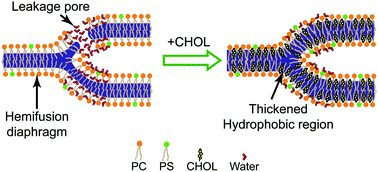Cholesterol suppresses membrane leakage by decreasing water penetrability†
Abstract
Membrane fusion is a fundamental biological process that lies at the heart of enveloped virus infection, synaptic signaling, intracellular vesicle trafficking, gamete fertilization, and cell–cell fusion. Membrane fusion is initiated as two apposed membranes merge to a single bilayer called a hemifusion diaphragm. It is believed that the contents of the two fusing membranes are released through a fusion pore formed at the hemifusion diaphragm, and yet another possible pathway has been proposed in which an undefined pore may form outside the hemifusion diaphragm at the apposed membranes, leading to the so-called leaky fusion. Here, we performed all-atom molecular dynamics simulations to study the evolution of the hemifusion diaphragm structure with various lipid compositions. We found that the lipid cholesterol decreased water penetrability to inhibit leakage pore formation. Biochemical leakage experiments support these simulation results. This study may shed light on the underlying mechanism of the evolution pathways of the hemifusion structure, especially the understanding of content leakage during membrane fusion.



 Please wait while we load your content...
Please wait while we load your content...